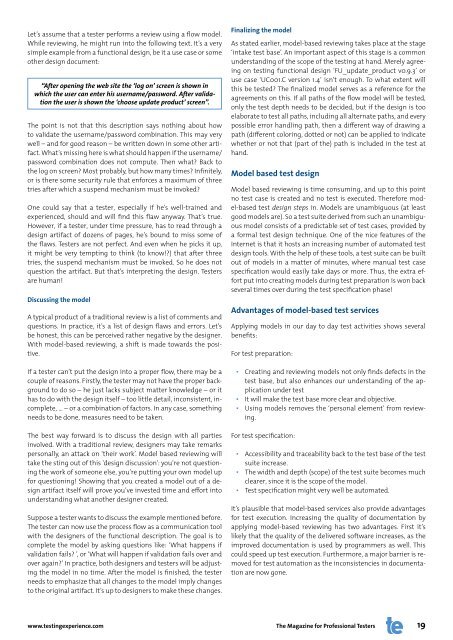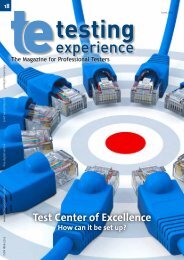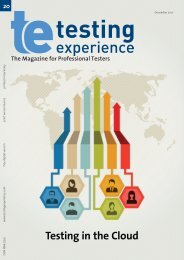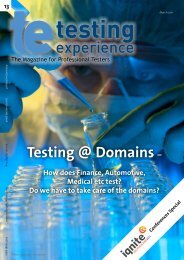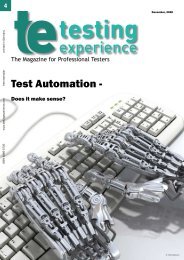Model-Based Testing - Testing Experience
Model-Based Testing - Testing Experience
Model-Based Testing - Testing Experience
You also want an ePaper? Increase the reach of your titles
YUMPU automatically turns print PDFs into web optimized ePapers that Google loves.
Let’s assume that a tester performs a review using a flow model.<br />
While reviewing, he might run into the following text. It’s a very<br />
simple example from a functional design, be it a use case or some<br />
other design document:<br />
“After opening the web site the ‘log on’ screen is shown in<br />
which the user can enter his username/password. After validation<br />
the user is shown the ‘choose update product’ screen”.<br />
The point is not that this description says nothing about how<br />
to validate the username/password combination. This may very<br />
well – and for good reason – be written down in some other artifact.<br />
What’s missing here is what should happen if the username/<br />
password combination does not compute. Then what? Back to<br />
the log on screen? Most probably, but how many times? Infinitely,<br />
or is there some security rule that enforces a maximum of three<br />
tries after which a suspend mechanism must be invoked?<br />
One could say that a tester, especially if he’s well-trained and<br />
experienced, should and will find this flaw anyway. That’s true.<br />
However, if a tester, under time pressure, has to read through a<br />
design artifact of dozens of pages, he’s bound to miss some of<br />
the flaws. Testers are not perfect. And even when he picks it up,<br />
it might be very tempting to think (to know!?) that after three<br />
tries, the suspend mechanism must be invoked. So he does not<br />
question the artifact. But that’s interpreting the design. Testers<br />
are human!<br />
Discussing the model<br />
A typical product of a traditional review is a list of comments and<br />
questions. In practice, it’s a list of design flaws and errors. Let’s<br />
be honest, this can be perceived rather negative by the designer.<br />
With model-based reviewing, a shift is made towards the positive.<br />
If a tester can’t put the design into a proper flow, there may be a<br />
couple of reasons. Firstly, the tester may not have the proper background<br />
to do so – he just lacks subject matter knowledge – or it<br />
has to do with the design itself – too little detail, inconsistent, incomplete,<br />
... – or a combination of factors. In any case, something<br />
needs to be done, measures need to be taken.<br />
The best way forward is to discuss the design with all parties<br />
involved. With a traditional review, designers may take remarks<br />
personally, an attack on ‘their work’. <strong>Model</strong> based reviewing will<br />
take the sting out of this ‘design discussion’: you’re not questioning<br />
the work of someone else, you’re putting your own model up<br />
for questioning! Showing that you created a model out of a design<br />
artifact itself will prove you’ve invested time and effort into<br />
understanding what another designer created.<br />
Suppose a tester wants to discuss the example mentioned before.<br />
The tester can now use the process flow as a communication tool<br />
with the designers of the functional description. The goal is to<br />
complete the model by asking questions like: ‘What happens if<br />
validation fails? ’, or ‘What will happen if validation fails over and<br />
over again?’ In practice, both designers and testers will be adjusting<br />
the model in no time. After the model is finished, the tester<br />
needs to emphasize that all changes to the model imply changes<br />
to the original artifact. It’s up to designers to make these changes.<br />
www.testingexperience.com<br />
Finalizing the model<br />
As stated earlier, model-based reviewing takes place at the stage<br />
‘intake test base’. An important aspect of this stage is a common<br />
understanding of the scope of the testing at hand. Merely agreeing<br />
on testing functional design ‘FU_update_product v0.9.3’ or<br />
use case ‘UC001.C version 1.4’ isn’t enough. To what extent will<br />
this be tested? The finalized model serves as a reference for the<br />
agreements on this. If all paths of the flow model will be tested,<br />
only the test depth needs to be decided, but if the design is too<br />
elaborate to test all paths, including all alternate paths, and every<br />
possible error handling path, then a different way of drawing a<br />
path (different coloring, dotted or not) can be applied to indicate<br />
whether or not that (part of the) path is included in the test at<br />
hand.<br />
<strong>Model</strong> based test design<br />
<strong>Model</strong> based reviewing is time consuming, and up to this point<br />
no test case is created and no test is executed. Therefore model-based<br />
test design steps in. <strong>Model</strong>s are unambiguous (at least<br />
good models are). So a test suite derived from such an unambiguous<br />
model consists of a predictable set of test cases, provided by<br />
a formal test design technique. One of the nice features of the<br />
Internet is that it hosts an increasing number of automated test<br />
design tools. With the help of these tools, a test suite can be built<br />
out of models in a matter of minutes, where manual test case<br />
specification would easily take days or more. Thus, the extra effort<br />
put into creating models during test preparation is won back<br />
several times over during the test specification phase!<br />
Advantages of model-based test services<br />
Applying models in our day to day test activities shows several<br />
benefits:<br />
For test preparation:<br />
▪ Creating and reviewing models not only finds defects in the<br />
test base, but also enhances our understanding of the application<br />
under test<br />
▪ It will make the test base more clear and objective.<br />
▪ Using models removes the ‘personal element’ from reviewing.<br />
For test specification:<br />
▪ Accessibility and traceability back to the test base of the test<br />
suite increase.<br />
▪ The width and depth (scope) of the test suite becomes much<br />
clearer, since it is the scope of the model.<br />
▪ Test specification might very well be automated.<br />
It’s plausible that model-based services also provide advantages<br />
for test execution. Increasing the quality of documentation by<br />
applying model-based reviewing has two advantages. First it’s<br />
likely that the quality of the delivered software increases, as the<br />
improved documentation is used by programmers as well. This<br />
could speed up test execution. Furthermore, a major barrier is removed<br />
for test automation as the inconsistencies in documentation<br />
are now gone.<br />
The Magazine for Professional Testers<br />
19


